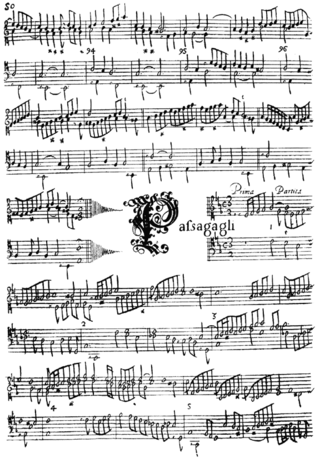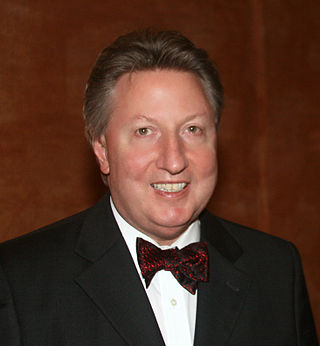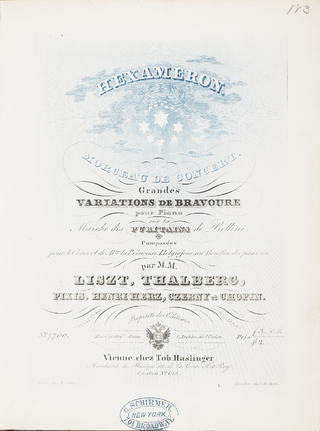Related Research Articles

A chaconne is a type of musical composition often used as a vehicle for variation on a repeated short harmonic progression, often involving a fairly short repetitive bass-line which offers a compositional outline for variation, decoration, figuration and melodic invention. In this it closely resembles the passacaglia. It originates and was particularly popular in the Baroque era; a large number of Chaconnes exist from the 17th- and 18th- centuries.

The passacaglia is a musical form that originated in early seventeenth-century Spain and is still used today by composers. It is usually of a serious character and is often based on a bass-ostinato and written in triple metre.

A suite, in Western classical music and jazz, is an ordered set of instrumental or orchestral/concert band pieces. It originated in the late 14th century as a pairing of dance tunes and grew in scope to comprise up to five dances, sometimes with a prelude, by the early 17th century. The separate movements were often thematically and tonally linked. The term can also be used to refer to similar forms in other musical traditions, such as the Turkish fasıl and the Arab nuubaat.
In music, variation is a formal technique where material is repeated in an altered form. The changes may involve melody, rhythm, harmony, counterpoint, timbre, orchestration or any combination of these.
Bagatelle sans tonalité is a piece for solo piano written by Franz Liszt in 1885. The manuscript bears the title "Fourth Mephisto Waltz" and may have been intended to replace the piece now known as the Fourth Mephisto Waltz when it appeared Liszt would not be able to finish it; the phrase Bagatelle ohne Tonart actually appears as a subtitle on the front page of the manuscript.
The Mephisto Waltzes are four waltzes composed by Franz Liszt from 1859 to 1862, from 1880 to 1881, and in 1883 and 1885. Nos. 1 and 2 were composed for orchestra, and later arranged for piano, piano duet and two pianos, whereas nos. 3 and 4 were written for piano only. Of the four, the first is the most popular and has been frequently performed in concert and recorded.
Réminiscences de Don Juan is an opera fantasy for piano by Franz Liszt on themes from Mozart's 1787 opera Don Giovanni.

The Fantasy on Themes from Mozart's Figaro and Don Giovanni, S.697, is an operatic paraphrase for solo piano by Franz Liszt, based on themes from two different Mozart's operas: The Marriage of Figaro, K.492 and Don Giovanni, K.527.

The sonatas and partitas for solo violin are a set of six works composed by Johann Sebastian Bach. They are sometimes referred to in English as the sonatas and partias for solo violin in accordance with Bach's headings in the autograph manuscript: "Partia" was commonly used in German-speaking regions during Bach's time, whereas the Italian "partita" was introduced to this set in the 1879 Bach Gesellschaft edition, having become standard by that time. The set consists of three sonatas da chiesa in four movements and three partitas in dance-form movements. The 2nd Partita is widely known for its Chaconne, considered one of the most masterly and expressive works ever written for solo violin.

The Partita in D minor for solo violin by Johann Sebastian Bach was written between 1717 and 1720. It is a part of his compositional cycle called Sonatas and Partitas for Solo Violin.

Earl Wild was an American pianist known for his transcriptions of jazz and classical music.

Almira, Königin von Castilien is George Frideric Handel's first opera, composed when he was 19 years old. It was first performed in Hamburg in January 1705.

Leslie John Howard is an Australian pianist, musicologist and composer. He is best known for being the only pianist to have recorded the complete solo piano works of Franz Liszt, a project which included more than 300 premiere recordings. He has been described by The Guardian as "a master of a tradition of pianism in serious danger of dying out".

Hexaméron, Morceau de concert S.392 is a collaborative composition for solo piano. It consists of six variations on a theme, along with an introduction, connecting interludes and a finale. The theme is the "March of the Puritans" from Vincenzo Bellini's opera I puritani.
The Passacaglia on DSCH is a large-scale composition for solo piano by the British composer Ronald Stevenson. It was composed between 24 December 1960 and 18 May 1962, except for two sections added on the day of the first performance on 10 December 1963. The composer presented a copy of the score to Dmitri Shostakovich, its dedicatee, at the 1962 Edinburgh Festival.
The radical change Franz Liszt's compositional style underwent in the last 20 years of his life was unprecedented in Western classical music. The tradition of music had been one of unified progression, even to the extent of Johannes Brahms' First Symphony being known as "Beethoven's Tenth". Beethoven's own three periods of composition are monolithic and united. Liszt's, by comparison, seem deconstructivist. Replacing pages which in Liszt's earlier compositions had been thick with notes and virtuoso passages was a starkness where every note and rest was carefully weighed and calculated, while the works themselves become more experimental harmonically and formally.

The Fantasy and Fugue on the chorale "Ad nos, ad salutarem undam", S.259, is a piece of organ music composed by Franz Liszt in the winter of 1850 when he was in Weimar. The chorale on which the Fantasy and Fugue is based was from Act I of Giacomo Meyerbeer's opera Le prophète. The work is dedicated to Meyerbeer, and it was given its premiere on October 29, 1852. The revised version was premiered in the Merseburg Cathedral on September 26, 1855, with Alexander Winterberger performing. The whole work was published by Breitkopf & Härtel in 1852, and the fugue was additionally published as the 4th piece of Liszt's operatic fantasy "Illustrations du Prophète" (S.414). A piano duet version by Liszt appeared during the same time (S.624).

Walter Bache was an English pianist and conductor noted for his championing the music of Franz Liszt and other music of the New German School in England. He studied privately with Liszt in Italy from 1863 to 1865, one of the few students allowed to do so, and continued to attend Liszt's master classes in Weimar, Germany regularly until 1885, even after embarking on a solo career. This period of study was unparalleled by any other student of Liszt and led to a particularly close bond between Bache and Liszt. After initial hesitation on the part of English music critics because he was a Liszt pupil, Bache was publicly embraced for his keyboard prowess, even as parts of his repertoire were questioned.
Although Franz Liszt provided opus numbers for some of his earlier works, they are rarely used today. Instead, his works are usually identified using one of two different cataloging schemes:
References
- Baker, James M., ed. Kenneth Hamilton, "A survey of the late piano works", The Cambridge Companion to Liszt (Cambridge and New York: Cambridge University Press, 2005). ISBN 0-521-64462-3 (paperback).
- Hinson, Maurice, The Pianist's Guide to Transcriptions, Arrangements, and Paraphrases (Indiana University Press). ISBN 978-0-253-21456-0
- Howard, Leslie, Notes for Hyperion CDA66371/2, Liszt at the Opera I, Leslie Howard, piano.